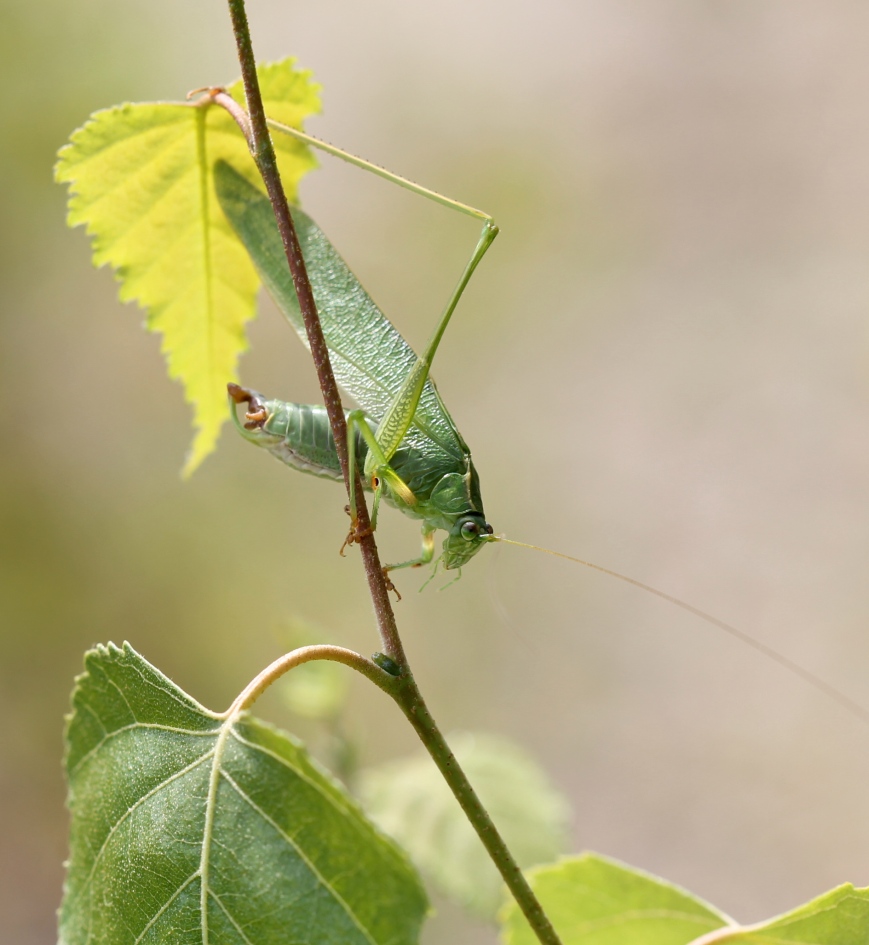
A male fork-tailed bush katydid perched on a birch (ha!) twig (Sanbornville, NH).
The katydids of the genus Scudderia, often known as bush katydids, are among the most commonly encountered katydids in the U.S. Legions of photos of the small, colorfully banded nymphs are posted to BugGuide and iNaturalist every spring, and images of the adults are equally abundant. The habits of Scudderia are generally similar, with the majority of species living in deciduous shrubby areas and feeding on broadleafed foliage and flowers (of course, there are exceptions). Eggs are laid inside leaves between the two layers, a most interesting sight to see. Species in the genus are very similar, and best told apart by the shape of the male’s supra-anal plate. There are 8 species recorded from the U.S, six of which I have seen. The two that I am still on the lookout for, S. cuneata and S. mexicana, have restricted ranges (the far southeast and southwest, respectively), while the other species are more widespread. Here I will briefly discuss the species I have seen with some notes on what I have observed.
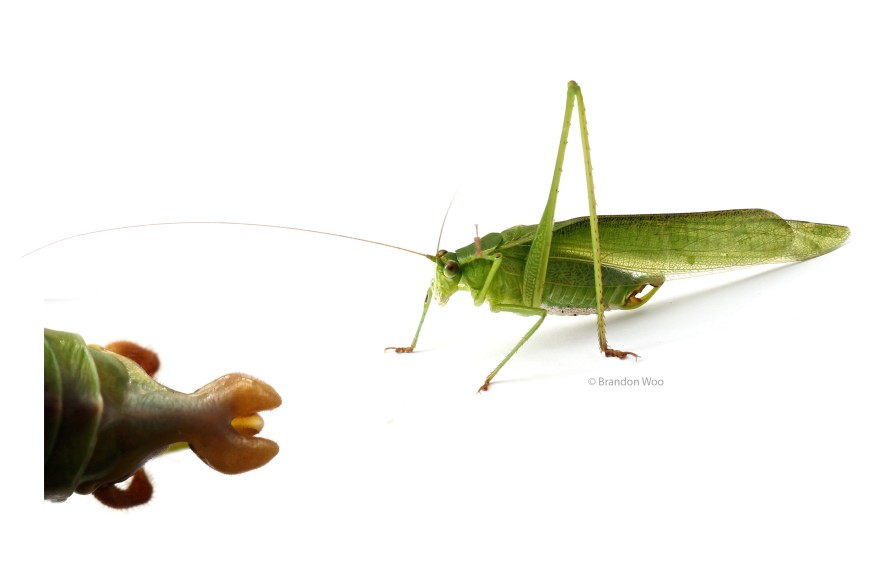
Scudderia “gimme a high five” furcata (Bear, DE)
By far the most ubiquitous bush katydid is the fork-tailed, Scudderia furcata. The only species found coast to coast and in every U.S. state, this guy could turn up in most habitats. I have seen them in forests, shrubby meadows, tall grass fields, swamps, marshes, suburban habitats, gardens, and sometimes at lights. The species is named for the large, inflated supra-anal plate that is shaped like a horseshoe. The ovipositor is almost always brown in my observation. This is the Scudderia that I usually see survive longest into the fall; I even found one enterprising individual in early November once! He was browned with age, but still managed to call a few times: a single “tsip” repeated once or twice every 10 minutes or so. This obviously makes them a real challenge to track down by song.
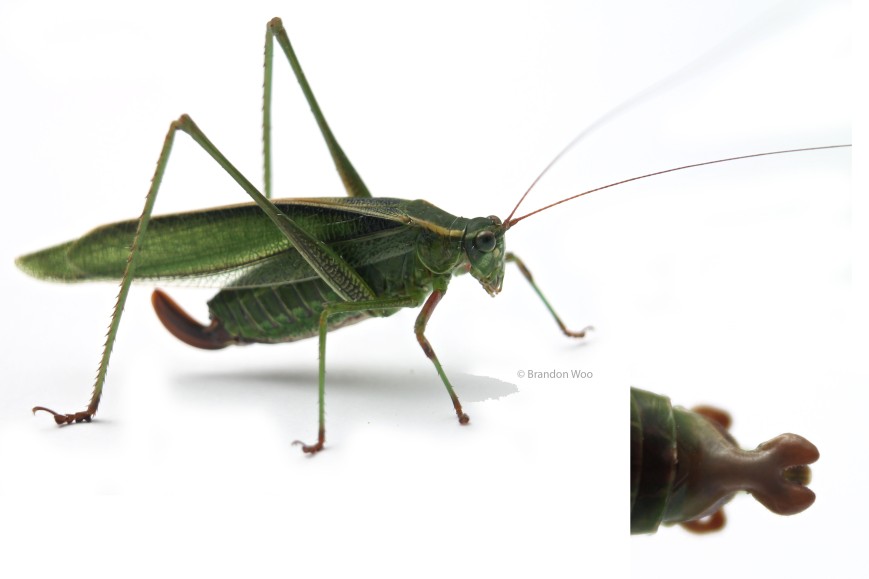
Scudderia fasciata (South Berwick, ME)
The species most easily confused with the fork-tailed is S. fasciata, the treetop bush katydid. Found in the northeast from Michigan to Maine, this animal has an almost identical call and supra-anal plate to S. furcata, but differs strikingly in habitat and coloration. The treetop katydid is found almost exclusively in canopies of coniferous trees, and fittingly has dark striping on the wings to blend in with conifer needles, along with a wine-colored belly and ovipositor. I have only seen an individual once in real habitat; however they regularly show up at lights. I wrote about an interesting incident with one of these creatures here.
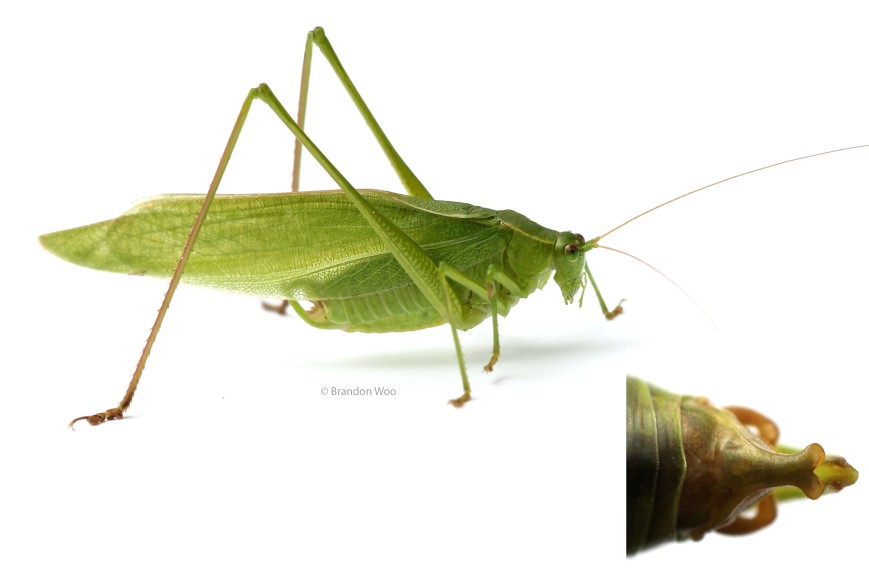
Scudderia curvicauda (Ithaca, NY)
Scudderia curvicauda, the curve-tailed bush katydid, is a large, widespread eastern species. They tend to inhabit open meadows, often with goldenrod. I don’t come across them too often but when I do, they are plentiful. The call is a series of 3-4 tsips, repeated every few minutes. They are named for the male supra-anal plate which resembles a whale’s fluke from above. The female’s ovipositor is usually green in my experience.
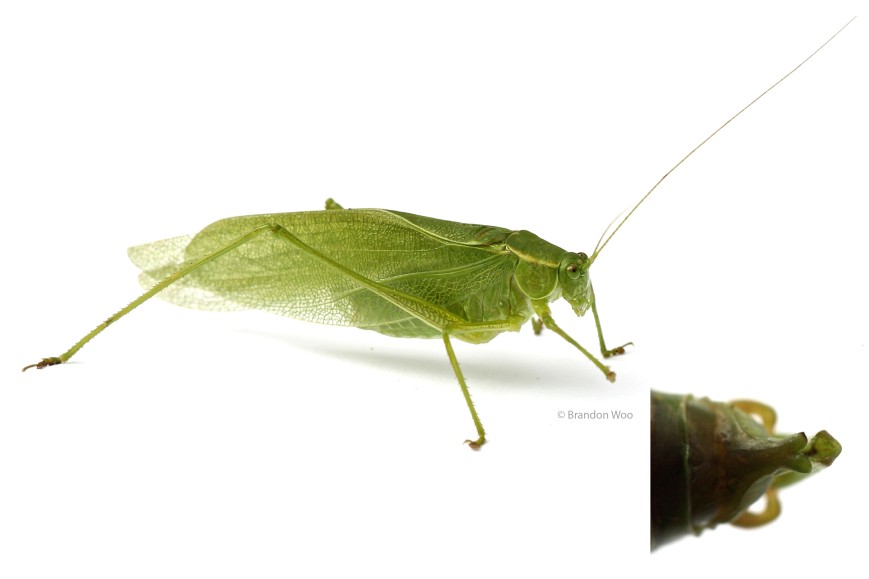
Scudderia pistillata (Alton Bay, NH)
The most northern of the Scudderia is the broad-winged bush katydid, S. pistillata. Aptly named, it is the only bush katydid with the outer wing length only three times its width. Its supra-anal plate is very similar to that of S. curvicauda, but subtly different–see the photos. I tend to see this species in wet goldenrod meadows, typically rather early in the season (July). The broad-winged bush katydid is notable for its ability to “count”. With each successive song, a calling male adds one or two buzzes. Females have been shown to prefer males who can “count” the highest.
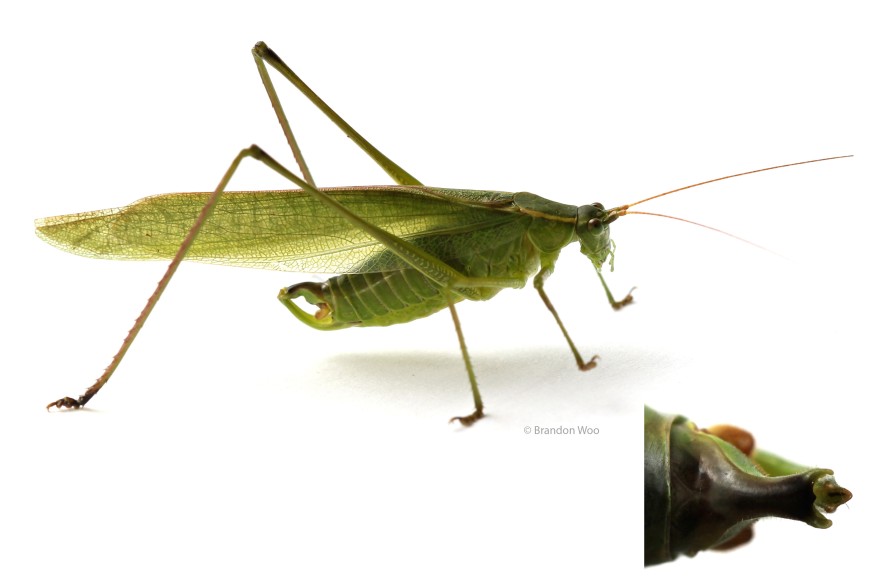
Scudderia texensis (Derby, IN)
We next come to the large Scudderia texensis, perhaps misnamed Texas bush katydid, which is actually distributed across the entire eastern U.S. Supposedly very common in many habitats, this is a species which I saw for the first time this year, in southern Indiana. I recognized it immediately by its distinctive supra-anal plate, which has a small tooth in the middle. I have been looking for this animal for years, checking every Scudderia that I come across, and never found it in a lot of likely habitats. Perhaps I am simply missing something, but I think this animal is a lot less common than the range maps suggest.
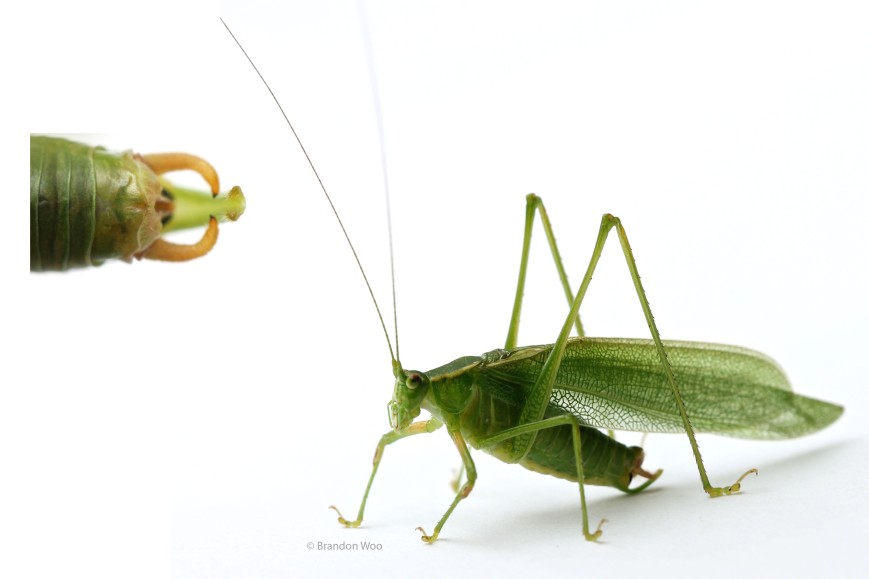
Scudderia septentrionalis (Ithaca, NY)
Finally we have Scudderia septentrionalis, the Northern bush katydid. Here is a supreme irony: septentrionalis is a supposedly rare species that I see very commonly, while texensis is a supposedly common species that I have only seen once. The northern bush katydid is distinctive for its lack of a supra-anal plate, having instead a blunt, truncated end to the abdomen. This is a species of the high deciduous canopy, with the most complex song of all the bush katydids: a series of ticks followed by “tzee-tzee-tzee-tzee”. I was hearing this species up in the trees long before I knew what I was listening to. A lot of the literature mentions this species as extremely rare; indeed, never have I come across one in habitat, but this is the Scudderia that is most strongly attracted to lights, and this is how you find them. I have been at lights where there were over 30 individuals jumping and flying and bouncing off of everything. To see septentrionalis you have to time your hunt just right: they have a short window of emergence, usually lasting from mid July to early August.
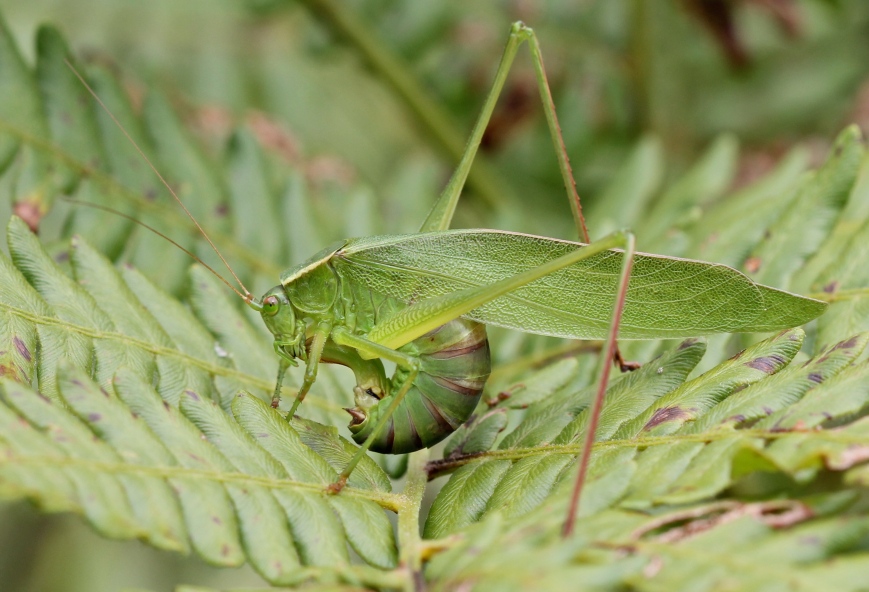
A female curve-tailed bush katydid cleaning her ovipositor (Old Orchard Beach, ME).
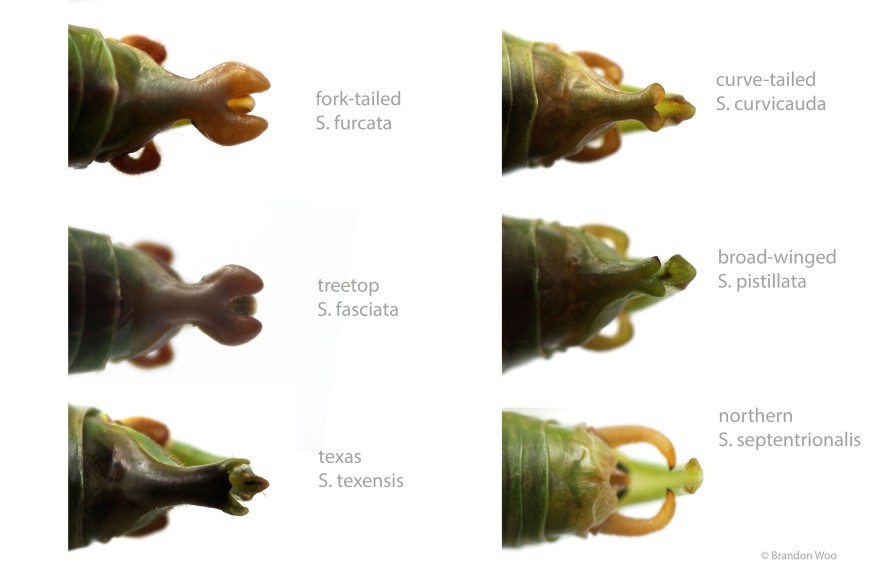
A collage of the various Scudderia supra-anal plates.
